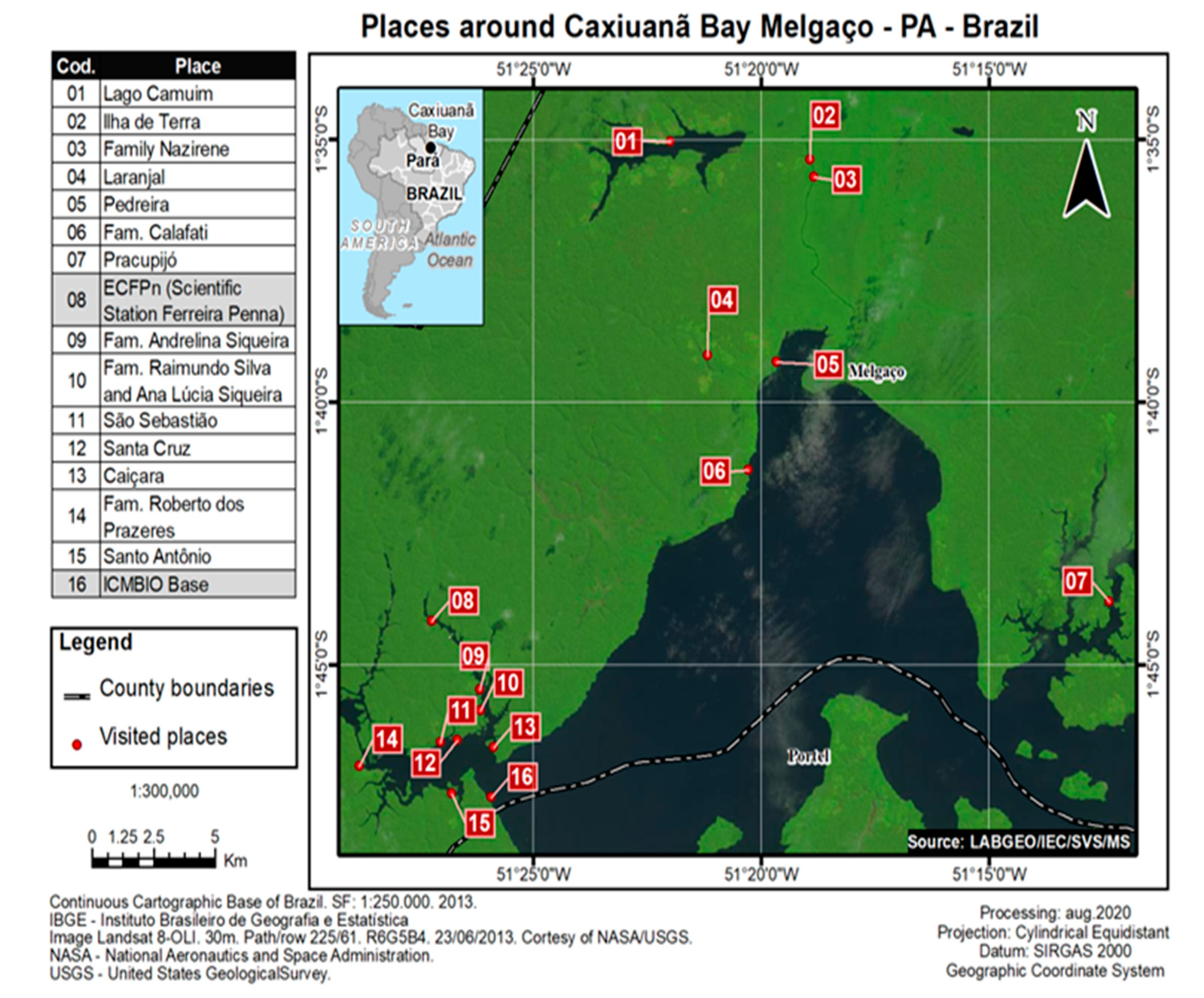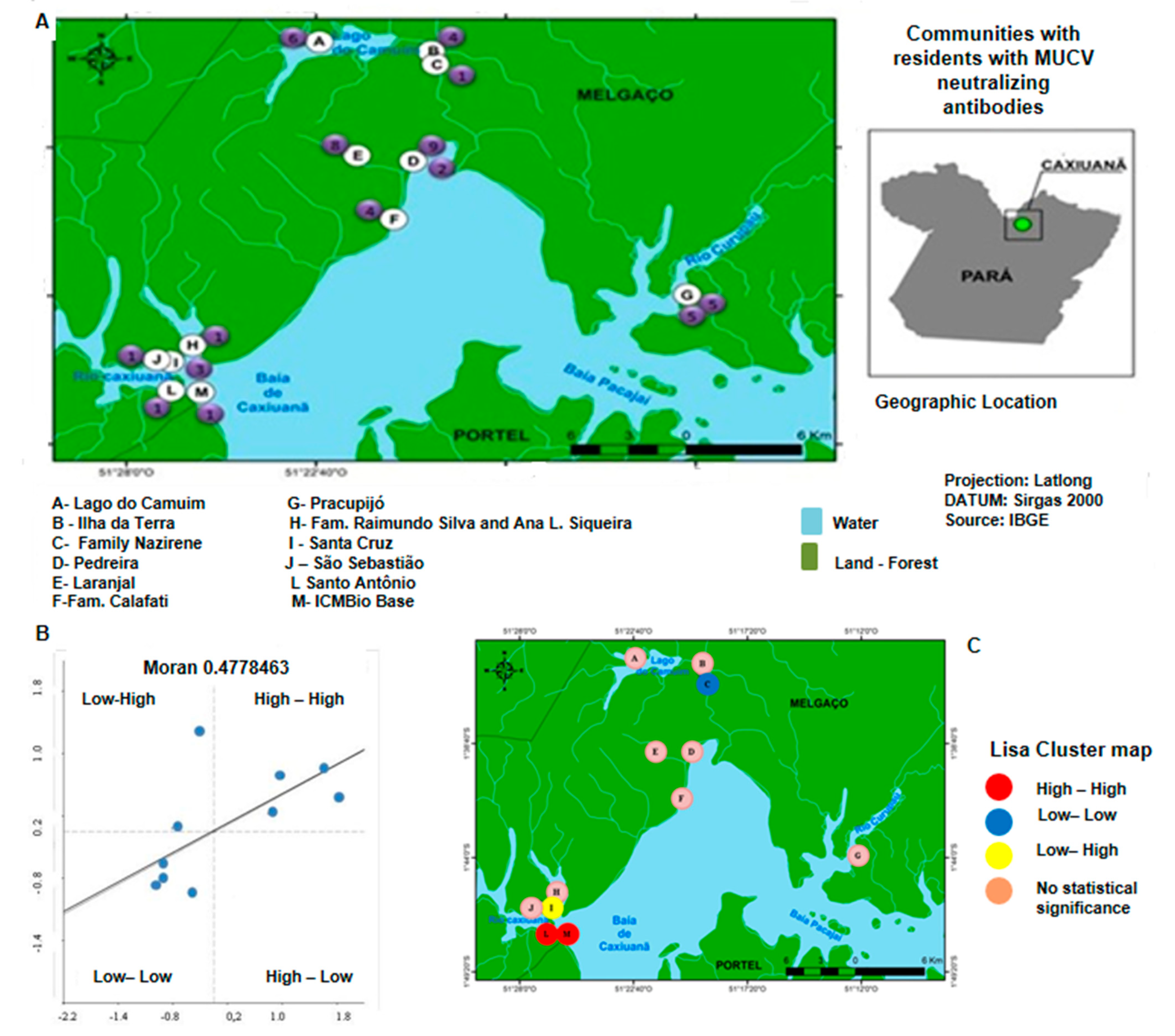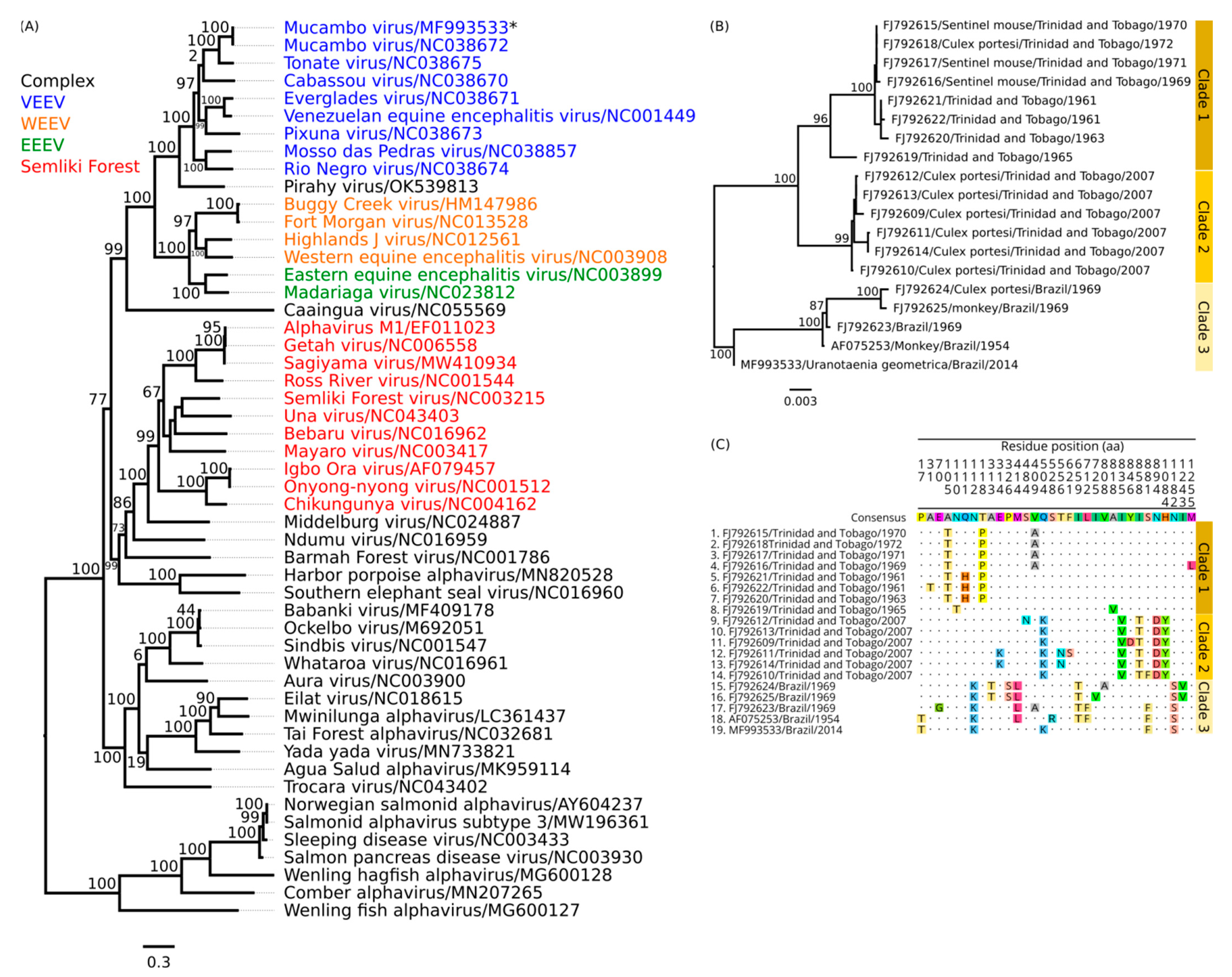Serological and Molecular Evidence of the Circulation of the Venezuelan Equine Encephalitis Virus Subtype IIIA in Humans, Wild Vertebrates and Mosquitos in the Brazilian Amazon
Abstract
:1. Introduction
2. Materials and Methods
2.1. Place of Study
2.2. Population
2.3. Ethical Aspects
2.4. Serological Studies
2.5. RT-PCR Screening
2.6. Nucleotide Sequencing, De Novo Assembling and Phylogenetic Tree
2.7. Statistical Analysis
3. Results
4. Discussion
Author Contributions
Funding
Institutional Review Board Statement
Informed Consent Statement
Conflicts of Interest
References
- WHO Scientific Group on Arboviruses and Human Disease; World Health Organization. Arboviruses and Human Disease: Report of a Who Scientific Group; Meeting Held in Geneva from 26 September to 1 October 1966; World Health Organization: Geneva, Switzerland, 1967. [Google Scholar]
- Pinheiro, F.P.; Travassos da Rosa, A.P.A.; Freitas, R.B.; Travassos da Rosa, J.F.S.; Vasconcelos, P.F.C. Aspectos clínicos-epidemiológicos das arboviroses. In INSTITUTO EVANDRO CHAGAS. 50 anos de Contribuição ás Ciências Biológicas e a Medicina Tropical, 1st ed.; Fundação Serviços de Saúde Pública: Belém, Brazil, 1986; Volume 2, pp. 375–408. [Google Scholar]
- Vasconcelos, P.F.C.; Travassos da Rosa, A.P.A.; Dégallier, N.; Travassos da Rosa, J.F.S.; Pinheiro, F.P. Clinical and ecoepidemiological situation of human arboviruses in Brazilian Amazonia. J. Braz. Assoc. Advanc. Sci. 1992, 44, 117–124. [Google Scholar]
- Araujo, P.A.; Freitas, M.O.; Chiang, J.O.; Silva, F.A.; Chagas, L.L.; Casseb, S.M.; Silva, S.P.; Nunes-Neto, J.P.; Rosa-Júnior, J.W.; Nascimento, B.S.; et al. Investigation about the Occurrence of Transmission Cycles of Arbovirus in the Tropical Forest, Amazon Region. Viruses 2019, 9, 774. [Google Scholar] [CrossRef] [PubMed] [Green Version]
- Weaver, S.C.; Ferro, C.; Barrera, R.; Boshell, J.; Navarro, J.C. Venezuelan equine encephalitis. Annu. Rev. Entomol. 2004, 49, 141–174. [Google Scholar] [CrossRef] [PubMed]
- Shope, R.E.; Causey, O.R.; Andrade, A.H.P.; Theiler, M. The Venezuelan equine encephalomyelitis complex of group A Arthropod-borne a viruses, including Mucambo and Pixuna from the Amazon region of Brazil. Am. J. Trop. Med. Hyg. 1964, 13, 723. [Google Scholar] [CrossRef] [Green Version]
- Weaver, S.C.; Salas, R.; Rico-Hesse, R.; Ludwig, G.V.; Oberste, M.S.; Boshell, J.; Tesh, R.B. Re-emergence of epidemic Venezuelan equine encephalomyelitis in South America. VEE Study Group. Lancet 1996, 348, 436–440. [Google Scholar] [CrossRef]
- Confalonieri, U.E.C.; Costa Neto, C. Diversity of mosquito vectors (Diptera:Culicidae) in Caxiuanã, Pará, Brazil. Inter. Discip. Perspect. Infect. Dis. 2012, 2012, 1–8. [Google Scholar] [CrossRef] [PubMed] [Green Version]
- Clarke, D.H.; Casals, J. Techniques for hemagglutination and hemagglutination-inhibition with arthropod-borne viruses. Am. J. Trop. Med. Hyg. 1958, 7, 561–573. [Google Scholar] [CrossRef] [Green Version]
- Shope, R.E. The use of a micro hemagglutination- inhibition test to follow antibody response after arthropod-borne virus infection in a community of forest animals. An. Microbiol. 1963, 11, 167–169. [Google Scholar]
- Hammon, W.T. Arbovirus infection in man. In Diagnostic Procedures for Viral and Rickettsial Diseases; Lennette, E.H., Schmidt, N.J., Eds.; American Public Health Association: New York, NY, USA, 1970; pp. 268–311. [Google Scholar]
- Reed, L.J.; Muench, H. A simple method of estimating fifty per cents endpoints. Am. J. Epidemiol. 1938, 27, 493–497. [Google Scholar] [CrossRef]
- Pfeffer, M.; Kinney, R.M.; Kaaden, O.R. The alphavirus 3′-nontranslated region: Size heterogeneity and arrangement of repeated sequence arrangement of repeated elements. Virology 1998, 240, 100–108. [Google Scholar] [CrossRef] [PubMed] [Green Version]
- Peng, Y.; Leung, H.C.M.S.; Yiu, M.; Chin, F.Y.L. IDBA-UD: A de novo assembler for single-cell and metagenomic sequencing data with highly uneven depth. Bioinformatics 2012, 28, 1420–1428. [Google Scholar] [CrossRef] [PubMed] [Green Version]
- Buchfink, B.; Xie, C.; Huson, D.H. Fast and sensitive protein alignment using DIAMOND. Nat. Methods 2015, 12, 59–60. [Google Scholar] [CrossRef] [PubMed]
- Katoh, K.; Standley, D.M. MAFFT multiple sequence alignment software version 7: Improvements in performance and usability. Mol. Biol. Evol. 2013, 30, 772–780. [Google Scholar] [CrossRef] [PubMed] [Green Version]
- Darriba, D.; Taboada, G.L.; Doallo, R.; Posada, D. jModelTest 2: More models, new heuristics and parallel computing. Nat. Methods 2012, 9, 772. [Google Scholar] [CrossRef] [Green Version]
- Myung, J. Tutorial on maximum likelihood estimation. J. Math. Psycho. 2003, 47, 90–100. [Google Scholar] [CrossRef]
- Stamatakis, A. RAxML version 8: A tool for phylogenetic analysis and post-analysis of large phylogenies. Bioinformatics 2014, 30, 1312–1313. [Google Scholar] [CrossRef] [Green Version]
- Felsenstein, J. Confidence limits on phylogenies: An approach using the bootstrap. Evolution 1985, 39, 783–791. [Google Scholar] [CrossRef]
- Anselin, L.; Ibnu, S.; Youngihn, K. GeoDa: An Introduction to Spatial Data Analysis. Geogr. Anal. 2006, 38, 5–22. [Google Scholar] [CrossRef]
- Moran, P.A.P. The interpretation of statistical maps. J. R. Stat. Soc. B 1948, 37, 243–251. [Google Scholar] [CrossRef]
- Cheng, Y. New approaches of calculating Moran´s index of spatial autocorrelation. PLoS ONE 2013, 8, e68336. [Google Scholar] [CrossRef] [Green Version]
- Auguste, A.J.; Volk, S.M.; Arrigo, N.C.; Martinez, R.; Ramkissoon, V.; Adams, A.P.; Thompson, N.N.; Adesiyun, A.A.; Chadee, D.D.; Foster, J.E.; et al. Isolation and phylogenetic analysis of Mucambo virus (Venezuelan equine encephalitis complex subtype IIIA) in Trinidad. Virology 2009, 392, 123–130. [Google Scholar] [CrossRef] [PubMed] [Green Version]
- Vasconcelos, P.F.; Travasso da Rosa, J.F.; Travassos da Rosa, A.P.; Dégallier, N.; Pinheiro, F.P.; Sá Filho, G.C. Epidemiology of encephalitis caused by arbovirus in the Brazilian Amazonia. Rev. Inst. Med. Trop. Sao Paulo. 1991, 33, 465–476. [Google Scholar] [CrossRef] [PubMed]
- Auguste, A.J.; Adams, A.P.; Arrigo, N.C.; Martinez, R.; Travassos da Rosa, A.P.; Adesiyun, A.A.; Chadee, D.D.; Tesh, R.B.; Carrington, C.V.; Weaver, S.C. Isolation and characterization of sylvatic mosquito-borne viruses in Trinidad: Enzootic transmission and a new potential vector of Mucambo virus. Am. J. Trop. Med. Hyg. 2010, 6, 1262–1265. [Google Scholar] [CrossRef] [PubMed]
- Garcia, L.V.M.; Milan, E.; Antunes, D.A.; Moro, R.S. Plano de Manejo da Floresta Nacional de Caxiuanã (PA): Conflitos entre interesses de populações tradicionais e unidades de conservação. Terra Plural 2014, 8, 355–369. [Google Scholar]
- Silva, H.P.A. Demographic and medical-epidemiological aspects of residents in the Caxiuanã national forest, Melgaço, Pará, Brazil. In Caxiuanã: Populações Tradicionais, Meio Físico e Diversidade Biológica; Lisboa, P.L.B., Ed.; Museu Paraense Emílio Goeldi: Belém, Brazil, 2002; pp. 77–94. [Google Scholar]



| Human | Wild Vertebrates | |
|---|---|---|
| Hemagglutination inhibitor antibodies to the Alphavirus genus | 147/632 (23.3) | 13/63 (20.6) |
| Hemagglutination inhibitor antibodies to MUCV | 89/147 (60.5) | 13/63 (20.6) |
| Neutralizing antibodies to MUCV | 51/89 (57.3) | 8/13 (61.5) |
| 1 | 2 | 3 | 4 | 5 | 6 | 7 | 8 | 9 | 10 | ||
|---|---|---|---|---|---|---|---|---|---|---|---|
| 1 | Mucambo virus/NC038672 | 98.9 | 82.7 | 74.1 | 72.9 | 73.3 | 72.0 | 70.7 | 70.6 | 57.4 | |
| 2 | Mucambo virus/BeAr816662 | 99.6 | 83.1 | 74.1 | 72.9 | 73.1 | 72.0 | 70.8 | 70.6 | 57.4 | |
| 3 | Tonate virus/NC038675 | 92.9 | 93.0 | 73.7 | 72.9 | 73.4 | 71.5 | 71.0 | 70.3 | 57.7 | |
| 4 | Venezuelan Equine Encephalitis virus/NC001449 | 83.6 | 83.6 | 83.5 | 88.2 | 72.5 | 73.0 | 71.5 | 70.5 | 58.6 | |
| 5 | Everglades virus/NC038671 | 84.3 | 84.6 | 83.4 | 82.3 | 72.1 | 72.3 | 70.3 | 70.5 | 57.6 | |
| 6 | Cabassou virus/NC038670 | 83.5 | 83.6 | 82.7 | 81.3 | 94.8 | 70.5 | 70.4 | 70.1 | 58.2 | |
| 7 | Pixuna virus/NC038673 | 80.0 | 80.0 | 79.1 | 80.0 | 80.1 | 79.4 | 70.5 | 69.6 | 58.0 | |
| 8 | Rio Negro virus/NC038674 | 77.7 | 77.5 | 78.3 | 77.5 | 78.2 | 77.6 | 77.4 | 74.1 | 57.9 | |
| 9 | Mosso das Pedras virus/NC038857 | 78.2 | 78.3 | 77.8 | 77.3 | 79.4 | 78.2 | 77.8 | 83.6 | 57.4 | |
| 10 | Madariaga virus/NC023812 | 56.9 | 56.8 | 56.3 | 56.1 | 56.4 | 56.3 | 55.6 | 55.8 | 56.1 |
Publisher’s Note: MDPI stays neutral with regard to jurisdictional claims in published maps and institutional affiliations. |
© 2022 by the authors. Licensee MDPI, Basel, Switzerland. This article is an open access article distributed under the terms and conditions of the Creative Commons Attribution (CC BY) license (https://creativecommons.org/licenses/by/4.0/).
Share and Cite
Silva, F.A.; Ferreira, M.S.; Araújo, P.A.; Casseb, S.M.M.; Silva, S.P.; Nunes Neto, J.P.; Chiang, J.O.; Rosa Junior, J.W.; Chagas, L.L.; Freitas, M.N.O.; et al. Serological and Molecular Evidence of the Circulation of the Venezuelan Equine Encephalitis Virus Subtype IIIA in Humans, Wild Vertebrates and Mosquitos in the Brazilian Amazon. Viruses 2022, 14, 2391. https://doi.org/10.3390/v14112391
Silva FA, Ferreira MS, Araújo PA, Casseb SMM, Silva SP, Nunes Neto JP, Chiang JO, Rosa Junior JW, Chagas LL, Freitas MNO, et al. Serological and Molecular Evidence of the Circulation of the Venezuelan Equine Encephalitis Virus Subtype IIIA in Humans, Wild Vertebrates and Mosquitos in the Brazilian Amazon. Viruses. 2022; 14(11):2391. https://doi.org/10.3390/v14112391
Chicago/Turabian StyleSilva, Franko A., Milene S. Ferreira, Pedro A. Araújo, Samir M. M. Casseb, Sandro P. Silva, Joaquim P. Nunes Neto, Jannifer O. Chiang, José W. Rosa Junior, Liliane L. Chagas, Maria N. O. Freitas, and et al. 2022. "Serological and Molecular Evidence of the Circulation of the Venezuelan Equine Encephalitis Virus Subtype IIIA in Humans, Wild Vertebrates and Mosquitos in the Brazilian Amazon" Viruses 14, no. 11: 2391. https://doi.org/10.3390/v14112391








